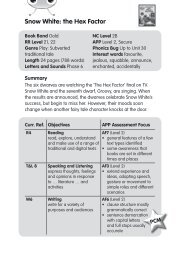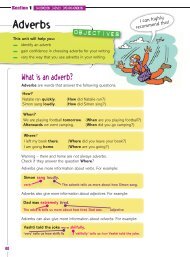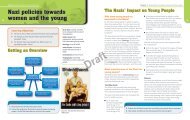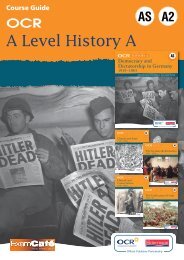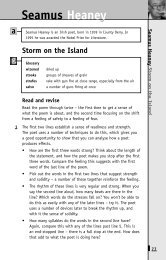Unit 1 Developing effective communication in health and social care
Unit 1 Developing effective communication in health and social care
Unit 1 Developing effective communication in health and social care
Create successful ePaper yourself
Turn your PDF publications into a flip-book with our unique Google optimized e-Paper software.
<strong>Unit</strong> 1 <strong>Develop<strong>in</strong>g</strong> <strong>effective</strong> <strong>communication</strong> <strong>in</strong> <strong>health</strong><br />
<strong>and</strong> <strong>social</strong> <strong>care</strong><br />
Scenario 2:<br />
BTEC Level 3 National Health <strong>and</strong> Social Care<br />
Aggressive response: ‘That’s not true! They’re the ones who are rude <strong>and</strong> you just want an excuse to pick on<br />
me.’ Assertive response: ‘Well, I disagree with you. Perhaps you could give me an example of when I have been<br />
rude.’ Submissive response: ‘Okay, you’re right. I’m not very good at this job.’<br />
AS11<br />
Assertive behaviour<br />
1. a S, b V, c A; 2. a A, b S, c V; 3. a A, b V, c S; 4. a A, b V, c S<br />
AS12<br />
Key terms<br />
Anagram Key term Anagram Key term<br />
gulganae citymumon language community sorseny tim<strong>in</strong>aremp sensory impairment<br />
grojan jargon mumcat<strong>in</strong>oonic sibidaity <strong>communication</strong> disability<br />
letacid dialect sumatisnop assumption<br />
angls slang saluve values<br />
stirf gulganae first language wormtenpeme empowerment<br />
rutalluc travionia cultural variation wrope power<br />
mumcat<strong>in</strong>oonic clecy <strong>communication</strong> cycle elfibe stemssy belief systems<br />
pugor slauve group values tenasrios assertion<br />
mumcat<strong>in</strong>oonic rirerab <strong>communication</strong> barrier sensellsheps helplessness<br />
grac<strong>in</strong> esencepr car<strong>in</strong>g presence fles-smeete self-esteem<br />
maphety empathy catodave advocate<br />
Group values: Group members share a common system of beliefs or values <strong>in</strong> order for the group to<br />
communicate <strong>and</strong> perform <strong>effective</strong>ly<br />
Reflective listen<strong>in</strong>g: Reflect<strong>in</strong>g back to the person what you th<strong>in</strong>k they said <strong>in</strong> order to check your<br />
underst<strong>and</strong><strong>in</strong>g<br />
Assertiveness: Be<strong>in</strong>g able to negotiate a solution to a problem<br />
Self-esteem: How you value or feel about yourself<br />
Car<strong>in</strong>g presence: Be<strong>in</strong>g open to the experience of another through a ‘two-way’ encounter with that person<br />
Stereotyp<strong>in</strong>g: A fixed way of th<strong>in</strong>k<strong>in</strong>g <strong>in</strong>volv<strong>in</strong>g generalisations <strong>and</strong> expectations about an issue or group.<br />
4 © Pearson Education Ltd 2010. Copy<strong>in</strong>g permitted for purchas<strong>in</strong>g <strong>in</strong>stitution only. This material is not copyright free.



